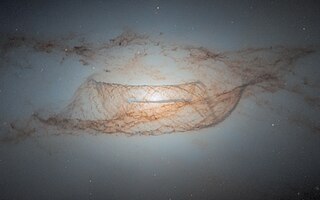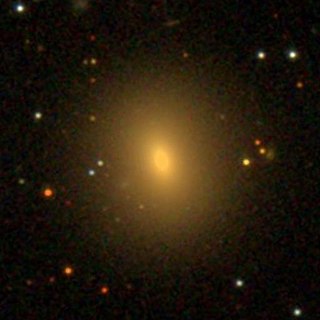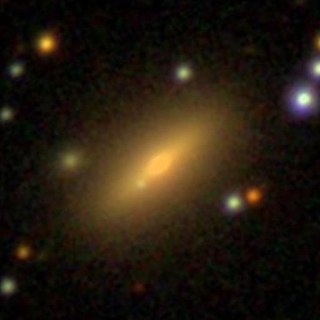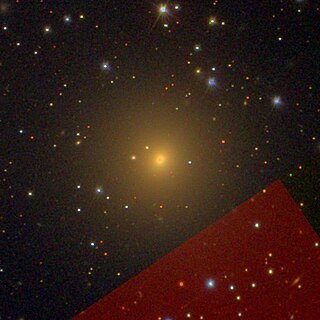
NGC 1277 is a lenticular galaxy in the constellation of Perseus. It is a member of the Perseus Cluster of galaxies and is located approximately 73 Mpc (megaparsecs) or 220 million light-years from the Milky Way. It has an apparent magnitude of about 14.7. It was discovered on December 4, 1875 by Lawrence Parsons, 4th Earl of Rosse.

NGC 4753 is a lenticular galaxy located about 60 million light-years away in the constellation of Virgo. NGC 4753 was discovered by astronomer William Herschel on February 22, 1784. It is notable for having distinct dust lanes that surround its nucleus. It is a member of the NGC 4753 Group of galaxies, which is a member of the Virgo II Groups, a series of galaxies and galaxy clusters strung out from the southern edge of the Virgo Supercluster.

NGC 4478 is an elliptical galaxy located about 50 million light-years away in the constellation Virgo. NGC 4478 was discovered by astronomer William Herschel on April 12, 1784. NGC 4478 is a member of the Virgo Cluster.

NGC 4564 is an elliptical galaxy located about 57 million light-years away in the constellation Virgo. NGC 4564 was discovered by astronomer William Herschel on March 15, 1784. The galaxy is also a member of the Virgo Cluster.

NGC 4570 is an edge-on lenticular galaxy located about 57 million light-years away in the constellation Virgo. NGC 4570 was discovered by astronomer William Herschel on April 13, 1784 and is a member of the Virgo Cluster.

NGC 3311 is a super-giant elliptical galaxy located about 190 million light-years away in the constellation Hydra. The galaxy was discovered by astronomer John Herschel on March 30, 1835. NGC 3311 is the brightest member of the Hydra Cluster and forms a pair with NGC 3309 which along with NGC 3311, dominate the central region of the Hydra Cluster.

NGC 1270 is an elliptical galaxy located about 250 million light-years away in the constellation Perseus. It was discovered by astronomer Heinrich d'Arrest on February 14, 1863. NGC 1270 is a member of the Perseus Cluster and has an estimated age of about 11 billion years. However, Greene et al. puts the age of NGC 1270 at about 15.0 ± 0.50 Gy.

NGC 1271 is a compact elliptical or lenticular galaxy located about 250 million light-years away in the constellation Perseus. The galaxy was discovered by astronomer Guillaume Bigourdan on November 14, 1884. NGC 1271 is a member of the Perseus Cluster and has a nuclear dust disk in its center. It also has an edge-on, intermediate-scale disk and has a central bulge. Like NGC 1277, NGC 1271 is a candidate "relic galaxy".

NGC 1272 is a massive elliptical galaxy located about 230 million light-years away in the constellation Perseus. It was discovered by astronomer Heinrich d'Arrest on February 14, 1863. NGC 1272 has an active nucleus and is the second brightest member of the Perseus Cluster after NGC 1275.

NGC 1281 is a compact elliptical galaxy located about 200 million light-years away in the constellation Perseus. NGC 1281 was discovered by astronomer John Dreyer on December 12, 1876. It is a member of the Perseus Cluster.

NGC 1282 is an elliptical galaxy located about 230 million light-years away in the constellation Perseus. It was discovered by astronomer Guillaume Bigourdan on October 23, 1884. NGC 1282 is a member of the Perseus Cluster.

NGC 3840 is a spiral galaxy located about 320 million light-years away in the constellation Leo. The galaxy was discovered by astronomer Heinrich d'Arrest on May 8, 1864. NGC 3840 is a member of the Leo Cluster. The galaxy is rich in neutral atomic hydrogen and is not interacting with its environment.

NGC 3844 is a lenticular galaxy located about 320 million light-years away in the constellation Leo. The galaxy was discovered by astronomer Heinrich d'Arrest on May 8, 1864. NGC 3844 is a member of the Leo Cluster and is likely to be a low-luminosity AGN (LLAGN).

NGC 3860 is a spiral galaxy located about 340 million light-years away in the constellation Leo. NGC 3860 was discovered by astronomer William Herschel on April 27, 1785. The galaxy is a member of the Leo Cluster and is a low-luminosity AGN (LLAGN). Gavazzi et al. however classified NGC 3860 as a strong AGN which may have been triggered by a supermassive black hole in the center of the galaxy.

NGC 3861 is a large barred spiral galaxy with a ring-like structure located about 310 million light-years away in the constellation Leo. It was discovered by astronomer John Herschel on March 23, 1827. NGC 3861 is a member of the Leo Cluster and has a normal amount of neutral hydrogen and ionised hydrogen.

NGC 4212 is a flocculent spiral galaxy with LINER activity located about 53 million light-years away in the constellation Coma Berenices. The galaxy was discovered by astronomer William Herschel on April 8, 1784, and was listed in the NGC catalog as NGC 4208. He then observed the same galaxy and listed it as NGC 4212. Astronomer John Louis Emil Dreyer later concluded that NGC 4208 was identical to NGC 4212. NGC 4212 is a member of the Virgo Cluster.

NGC 4222 is an edge-on spiral galaxy located about 60 million light-years away in the constellation Coma Berenices. It was discovered by astronomer William Herschel on April 8, 1784 and is often misidentified as IC 3087. NGC 4222 is a member of the Virgo Cluster and is a companion of NGC 4216 which lies about 180,000 ly (56 kpc) away. Despite this, the two galaxies are not interacting.

NGC 4076 is a spiral galaxy located 290 million light-years away in the constellation Coma Berenices. The galaxy was discovered by astronomer William Herschel on April 27, 1785 and is a member of the NGC 4065 Group.

NGC 4318 is a small lenticular galaxy located about 72 million light-years away in the constellation Virgo. It was discovered by astronomer John Herschel on January 18, 1828. NGC 4318 is a member of the Virgo W′ group, a group of galaxies in the background of the Virgo Cluster that is centered on the giant elliptical galaxy NGC 4365.

NGC 4589 is an elliptical galaxy located in the Draco constellation. It was discovered by German-British astronomer William Herschel on November 22, 1797. This galaxy lies at a distance of 73.0 million light-years (22.39 Mpc) from the Milky Way, and is receding with a heliocentric radial velocity of 2,002 km/s. It is known by its designations PGC 42139 or UGC 7797.




















